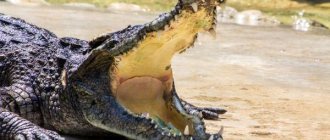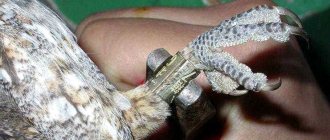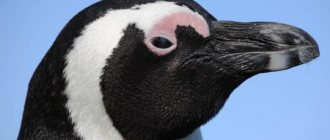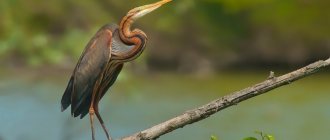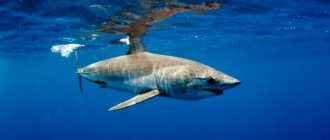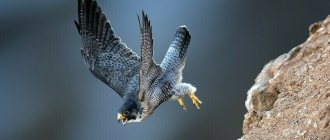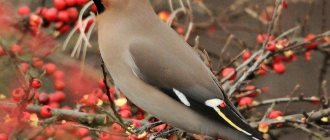Author: Great Mute
05 April 2022 20:08
Tags: animal facts photos
674
9
He will attack in broad daylight, rob, destroy your home... and all in order to give the squeezed tchotchkes to his beloved and only one! No, we are not talking about the hero of a cute novel for ladies of Balzac's age. Cue the music from Pirates of the Caribbean and get ready to get into the spirit of adventure, because we are talking about a robber who keeps all the feathered inhabitants of the seas in terror - the frigate.
Jack Sparrow. Bird version.
0
See all photos in the gallery
Setting: Tropical islands of the Pacific, Atlantic and Indian oceans. Nature of extraordinary beauty, sultry climate, exotic... and sea. A sea of dangers. Here everyone is hiding in fear, waiting for a gangster racket. And here he is - the culprit of everyone’s awe and also our main character - a frigate, a man and a steamship. More precisely, a bird and a steamboat. After all, the feathered creature received its name in honor of a combat ship for its no less combative character
Interesting Facts
- It is quite possible that the bird was called a frigate because of the formidable glory of this ship. Frigates are warships, and in Mediterranean countries, conquering corsairs often sailed on frigates, attacking other people’s ships for the purpose of profit. Just like our “air pirate”. Although it seems to us that frigate ships have one more remarkable quality - they could cruise at sea for a long time without entering a port. They were not laid up in peacetime, but were used for patrol and cruising service. This long stay at sea is also characteristic of our wonderful bird.
- Today, Polynesians still use frigates as carrier pigeons to send messages. Moreover, it is not difficult to tame them, despite their slightly absurd character. The key point is feeding fish. They are ready to do a lot for her.
- Frigates have excellent vision. From above, they notice the smallest fish, jellyfish or crustacean, which has carelessly risen to the surface, and dive on them.
- Frigate birds are strangely affected by bright colors. There were cases when they came across colorful pennant flags on ships from all over, apparently mistaking them for potential prey.
- On Noirou Island in Oceania, locals use tamed frigatebirds as “live fishing rods.” Birds catch fish, bring them ashore and throw them to people.
Aboard!
0
The throat bags, sailing like sails above the waves, mark the beginning of the raid. As soon as they see a squadron of crazed pirates, a more or less intelligent gannet, pelican, or even a petrel that has caught the catch will immediately take off running. After all, you can’t convince frigates that you’ve already eaten everything. Hiding the desired tasty treat in a beak or a thief's pocket will also not work. They will peck you until you die. Yours. So it’s better to abandon the prey, or at worst regurgitate it.
Frigate Ariel
The species is distributed in the tropical waters of the Indian and Atlantic oceans. Sometimes found in the Far East. The body length of the bird is from 71 to 81 cm, the wingspan is 175-195 cm. The weight of males is in the range of 625-875 g, in females it is slightly larger - from 750 to 950 g. The color of the male plumage is black with green, blue or purple low tide The upper part of the breast in females is white. For the frigate Ariel, there are three similar subspecies, which have different wingspans and beak lengths, as well as habitat: Fregata ariel ariel, distributed in the central and eastern waters of the Indian Ocean, in the west and center of the Pacific Ocean. Fregata ariel iredalei, inhabitant of the western Indian Ocean. Fregata ariel trinaitatis, lives in the south Atlantic Ocean, breeds exclusively on the island of Trindade.
The great frigatebird is one of the few seabird species that is characterized by sexual dimorphism in plumage color and size. Males are usually slightly smaller in size than females, their plumage is black throughout the body, and on the back it has a shiny greenish-violet color. In addition, the male is easily distinguished by a skin pouch located in the throat area, which during mating inflates very strongly and turns bright red. This special decoration is necessary for the male to attract females. The females, like the males, have a black back, and the plumage in the chest and belly is white. Young birds resemble females in plumage color, but their backs are brown.
Frigatebirds are monogamous birds that nest once every two or three years on sparsely populated islands and along the deserted coasts of continents. Since there are no predators on such islands, frigate birds are not afraid to build their nests in bushes or trees at a small height from the ground. Frigatebirds nest both in fairly large colonies (for example, there are about a thousand nests on Laisan Island) and in very small ones - up to 15 pairs.
Frigatebirds often arrange nesting sites together with gannets in order to subsequently take food from them. The timing of the mating season differs in different regions, which is usually due to the availability of sufficient food at a particular time. Before the construction of the nest begins, mating games take place between the frigates.
Males are located on trees and bushes, inflate their bright skin bags located on the throat, while raising their heads up and spreading their wings. They also make characteristic singing sounds. For several days, the females fly over this “orchestra” and choose a partner for themselves.
Frigate birds place their nests on low trees or bushes, and sometimes right on the ground. The place must be protected from the wind and well heated by the sun. The frigate bird's nest is similar to a platform that the birds construct from branches and other plant materials. In one clutch, the female always has one white egg, which is incubated alternately by both the male and the female.
They change with each other every 3-18 days. Incubation lasts from 40 to 50 days, after which a chick is born, completely devoid of down, so it is constantly warmed by an adult bird. At the age of 4 to 5 months, young birds have fully developed plumage and begin to fly; they differ from adults only in their white heads.
For another 7-8 months, the young frigatebird remains next to the nest, eats food that its parents bring to it, and enjoys their protection. Frigate birds reach sexual maturity at the age of 5 to 7 years.
A frigate chick shows the chick of another bird the open spaces of the sea. The wildlife is amazing.
0
Like any criminal, the frigate got on a slippery slope not because of a good life. Long wings are great for long flights and nimble movements in the air, but not for fishing. If the bird lands on the water, it will no longer be able to take off - it does not have enough scope. The same problem occurs with smooth surfaces. Short legs simply do not allow you to make a decent swing to rise into the air. So if a bird intends to go fishing, it will do it on the fly.
Lifestyle and habitat
The frigate bird lives on sea coasts and islands located in the tropics. In addition, they can be seen in Polynesia, as well as in the Seychelles and Galapagos Islands, in areas located in the subtropics. All oceans of the earth, having a tropical and subtropical zone, can boast that they have sheltered this bird on many of their islands and coasts.
Very agile in the air, they spend most of their time flying over the sea. They do not know how to swim; their plumage immediately absorbs water and pulls them to the bottom. This is due to the fact that frigate birds have a very poorly developed coccygeal gland, which is designed to impregnate the feathers with a waterproof composition, like most waterfowl. Therefore, they hone their flight skills in order to hunt fish.
Birds can soar in the sky for a long time thanks to their wings. They don’t even need to wave, they simply “hang” in the air flow. These living gliders make sharp and ornate turns in the air, chase each other, play and live a full life there.
Having descended to land, they are almost helpless. If they fall into the sight of a dangerous enemy, they will not escape on the ground. Too short weak legs and too long equipment - wings and tail.
Despite some limitations in approaching the ground, these birds have no difficulty in catching their own prey; they are inventive and skillful hunters. However, they do not hesitate to offend other aquatic birds, taking away their prey. Frigates often also steal material for building their own homes from other people's nests.
They usually nest in colonies, which are arranged near the nesting sites of gannets or other birds. Such proximity is not an accident, but an insidious forethought. In the future, they will take food from them. They usually live in nests during mating and incubation of chicks. They try to spend the rest of their time above the sea.
Waiting for prey at the surface, the bird skillfully hooks it from the air.
0
But even inveterate bandits have their own code of honor. Frigates are real gentlemen to their ladies. These pirates do not chase port girls, they choose a mate once and for life. During the mating season, the guy is literally bursting with tenderness. Moreover, the more he bursts, the higher the chance that he will find his chosen one. After all, the most attractive thing about a frigate is its sail, or rather, its throat pouch. He inflates it as much as he can. Usually, urine is enough for 25 cm in diameter. If a madam, enchanted by the charms, chooses you, and not the overdressed dude from the next branch, you can build a nest.
Nutrition
The frigatebird is a seabird, so it feeds mainly on fish. At the same time, like any predator, it will not refuse to catch, on occasion, a very small vertebrate animal, a mollusk or a jellyfish. Birds can also snatch a small crustacean from the water without landing on the surface. They spend long periods of time watching dolphins and predatory fish from the air as they chase flying fish. As soon as the latter appear from the water, the frigates catch them in flight.
The hunter can drop the caught prey several times, but then he always grabs it again before it touches the water. This is done to more dexterously grab the victim. Thus, during the hunt, he performs complex balancing act, like a real circus performer.
On land, they attack small turtles that have recently hatched. However, such a feast does not happen often. Therefore, cunning birds mastered the profession of “pirates”. They catch other birds returning from a successful hunt and attack them.
They begin to beat them with their wings and peck them with their beaks until the unfortunate ones let go of their prey or vomit. Robbers even manage to grab these pieces of food on the fly. They attack large birds in whole groups.
They can steal and eat a chick from the nest of another bird, simultaneously destroying this nest. In other words, they behave like “air gangsters.” In addition, they pick up from the surface of the sea not only small mollusks, jellyfish or crustaceans, but also pieces of carrion.
Further reading[edit]
- Diamond, A. W. (1973). "Notes on the Breeding and Behavior of the Magnificent Frigatebird" (PDF). Condor
.
75
(2):200–209. DOI: 10.2307/1365868. JSTOR 1365868. - Gonzalez, Monica; de la Cueva, Horacio (2007). "Apparent survival of adult magnificent frigatebirds at the breeding colony of Isla Isabel, Mexico." Waterfowl
.
30
(1):73–79. DOI: 10.1675/1524-4695 (2007)030[0073:ASOAMF]2.0.CO; 2. - Gonzalez-Jaramillo, Monica; Schloegl, Christian; de la Cueva, Horacio (2012). Fregata magnificens
as a Conservation Strategy ."
Southwestern Naturalist
.
57
(3):332–335. DOI: 10.1894/0038-4909-57.3.335. - Osorno, Jose Luis; Szekely, Tamás (2004). "Sexual conflict and parental care in magnificent frigatebirds: full compensation by abandoned females." Animal behavior
.
68
(2):337–342. DOI: 10.1016/j.anbehav.2003.06.027.
Links[edit]
- ^ a b BirdLife International (2012). "Fregata magnificens" IUCN Red List of Threatened Species
.
2012
. Retrieved November 26, 2013. Old form URL - ^ a b Hartog, J. C. den (1993). "An early note of the appearance of the Magnificent Frigatebird, Fregata magnificens Mathews, 1914, in the Cape Verde Islands: Columbus as an ornithologist". Zoologische Mededelingen
.
67
: 361–364. - ^ab Dunn, Oliver; Kelly, James E. Jr. (1989). Diario on Christopher Columbus's first voyage to America, 1492–1493. Norman, Okla., USA: University of Oklahoma Press. paragraph 45. ISBN 0-8061-2384-2.
- Suarez, Pedro Lopez; Hazevoet, Cornelis J; Palma, Luis (2013). “Has the magnificent frigate Fregata magnificens of the Cape Verde Islands reached the end of her journey?” (PDF). Zoologia Caboverdiana
.
3
(2): 82–86. - ^ ab Jobling, James A. (2010). Helm's Dictionary of Scientific Names for Birds. London: Christopher Helm. With. 164, 237. ISBN 978-1-4081-2501-4.
- ^ ab Jean-Baptiste, du Tertre (1667). Histoire générale des Antilles beatées par les François (in French). Volume 2. Paris: Thomas Joly. item 269, plate p. 246.
- ^ ab Dampier, James (1699) [1697]. Report on a new trip around the world. London: James Knapton. paragraph 49.
- ↑
Albin, Eleazar (1738). Natural History of Birds. Volume 3. p. 75 and plate 80 on the previous page. - Jobling, James A. (2010). Helm's Dictionary of Scientific Names for Birds. London, UK: Christopher Helm. paragraph 164. ISBN 978-1-4081-2501-4.
- Matthews, G. M. (1914). "On the species and subspecies of the genus Fregata". Australian Avian Record
.
2
(6): 120 (117–121). - Kennedy, Martin; Spencer, Hamish G (2004). "Phylogeny of frigate birds (Fregatidae) and tropical birds (Phaethonidae), two divergent groups of the traditional order Pelecaniformes, inferred from mitochondrial DNA sequences." Molecular phylogenetics and evolution
.
31
(1): 31–38. DOI: 10.1016/j.ympev.2003.07.007. PMID 15019606. - Horta, J; Garcia, E.F.J.; Kirwan, G.M.; Boesman, P. "The Magnificent Frigatebird (Fregata magnificens)". In del Hoyo, J; Elliott, A; Sargatal, J; Christie, DC; de Juana, E (ed.). Directory of the World's Living Birds
. Lynx Editions. Retrieved November 30, 2014. (subscription required) - Weimerskirch, Henri; Chastel, Olivier; Barbro, Christophe; Tostain, Olivier (2003). "Frigate Birds Fly High in Thermals" (PDF). Nature
.
421
(6921):333–334. DOI: 10.1038/421333a. PMID 12540890. - ^ abc Hauber, Mark E. (August 1, 2014). The Book of Eggs: A Guide to the Life-Size Eggs of Six Hundred Species of Birds. Chicago: University of Chicago Press. p. 127. ISBN 978-0-226-05781-1.
- "Fregata magnificens (magnificent frigate)". Animal Diversity Network
. Retrieved April 11, 2022. - ^ ab Hayler, Frank; Schreiber, E. A.; Miller, Joshua M; Levin, Iris I; Parker, Patricia Gee; Fleischer, Robert C (2011). "Long-term isolation of a highly mobile seabird in the Galapagos Islands". Proceedings of the Royal Society
B.
278
(707):817–825. DOI: 10.1098/rspb.2010.1342. PMC 3049043. PMID 20861041.
